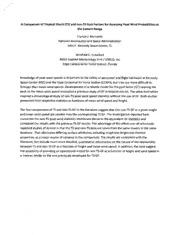
NASA Technical Reports Server (NTRS) 20130012962: A Comparison of Tropical Storm (TS) and Non-TS Gust Factors for Assessing Peak Wind Probabilities at the Eastern Range PDF
Preview NASA Technical Reports Server (NTRS) 20130012962: A Comparison of Tropical Storm (TS) and Non-TS Gust Factors for Assessing Peak Wind Probabilities at the Eastern Range
A Comparison of Tropical Storm (TS) and non-TS Gust Factors for Assessing Peak Wind Probabilities at the Eastern Range Francis J. Merceret National Aeronautics and Space Administration John F. Kennedy Space Center, FL Winifred C. Crawford NASA Applied Meteorology Unit / ENSCO, Inc Cape Canaveral Air Force Station, Florida Knowledge of peak wind speeds is important to the safety of personnel and flight hardware at Kennedy Space Center (KSC) and the Cape Canaveral Air Force Station (CCAFS), but they are more difficult to forecast than mean wind speeds. Development of a reliable model for the gust factor (GF) relating the peak to the mean wind speed motivated a previous study of GF in tropical storms. The same motivation inspired a climatological study of non-IS peak wind speed statistics without the use of GF. Both studies presented their respective statistics as functions of mean wind speed and height. The few comparisons of IS and non-TS GF in the literature suggest that the non-TS GF at a given height and mean wind speed are smaller than the corresponding TS GF. The investigation reported here converted the non-TS peak wind statistics mentioned above to the equivalent GF statistics and compared the results with the previous TS GF results. The advantage of this effort over all previously reported studies of its kind is that the IS and non-TS data are taken from the same towers in the same locations. That eliminates differing surface attributes, including roughness length and thermal properties, as a major source of variance in the comparison. The results are consistent with the literature, but include much more detailed, quantitative information on the nature of the relationship between TS and non-TS GF as a function of height and mean wind speed. In addition, the data suggest the possibility of providing an operational model for non-IS GF as a function of height and wind speed in a manner similar to the one previously developed for IS GF.
